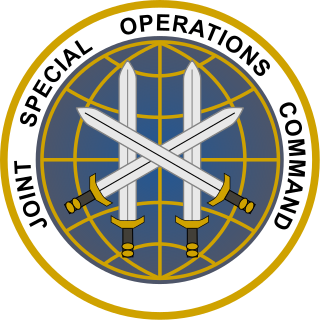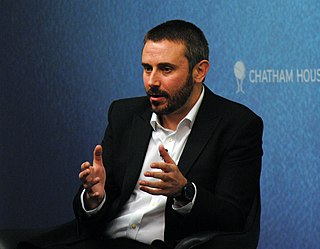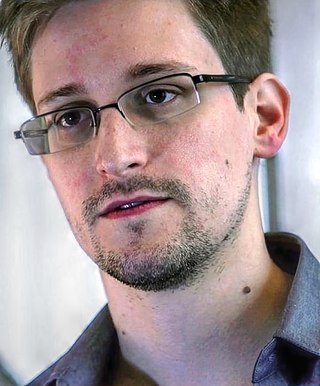Related Research Articles

The Joint Special Operations Command (JSOC) is a joint component command of the United States Special Operations Command (USSOCOM) and is charged with studying special operations requirements and techniques to ensure interoperability and equipment standardization, to plan and conduct special operations exercises and training, to develop joint special operations tactics, and to execute special operations missions worldwide. It was established in 1980 on recommendation of Colonel Charlie Beckwith, in the aftermath of the failure of Operation Eagle Claw. It is headquartered at Pope Field.

Russell D. Tice is a former intelligence analyst for the United States Air Force, Office of Naval Intelligence, Defense Intelligence Agency (DIA), and National Security Agency (NSA).

The Five Eyes (FVEY) is an Anglosphere intelligence alliance comprising Australia, Canada, New Zealand, the United Kingdom, and the United States. These countries are parties to the multilateral UK-USA Agreement, a treaty for joint cooperation in signals intelligence. Informally, Five Eyes can also refer to the group of intelligence agencies of these countries.

Anwar Nasser Abdulla al-Awlaki was an American-Yemeni Islamic scholar and lecturer who was killed in 2011 in Yemen by a U.S. government drone strike ordered by President Barack Obama. Al-Awlaki became the first U.S. citizen to be targeted and killed by a drone strike from the U.S. government. U.S. government officials argued that Awlaki was a key organizer for the Islamist terrorist group al-Qaeda, and in June 2014, a previously classified memorandum issued by the U.S. Department of Justice was released, justifying al-Awlaki's death as a lawful act of war. Civil liberties advocates have described the incident as "an extrajudicial execution" that breached al-Awlaki's constitutional right to due process, including a trial.

Jeremy Scahill is an American investigative journalist, writer, a founding editor of the online news publication The Intercept, and author of Blackwater: The Rise of the World's Most Powerful Mercenary Army, which won the George Polk Book Award. His book Dirty Wars: The World Is a Battlefield was published by Nation Books on April 23, 2013. On June 8, 2013, the documentary film of the same name, produced, narrated and co-written by Scahill, was released. It premiered at the 2013 Sundance Film Festival.

The Sam Adams Award is given annually since 2002 to an intelligence professional who has taken a stand for integrity and ethics. The Award is granted by the Sam Adams Associates for Integrity in Intelligence, a group of retired CIA officers. It is named after Samuel A. Adams, a CIA whistleblower during the Vietnam War, and takes the physical form of a "corner-brightener candlestick".

Targeted killing is a form of assassination carried out by governments outside a judicial procedure or a battlefield.

Abdulrahman Anwar al-Awlaki was a 16-year-old United States citizen who was killed by a drone strike on October 14, 2011, under a policy approved by U.S. President Barack Obama.

William "Bill" Edward Binney is a former intelligence official with the United States National Security Agency (NSA) and whistleblower. He retired on October 31, 2001, after more than 30 years with the agency.

PRISM is a code name for a program under which the United States National Security Agency (NSA) collects internet communications from various U.S. internet companies. The program is also known by the SIGAD US-984XN. PRISM collects stored internet communications based on demands made to internet companies such as Google LLC and Apple under Section 702 of the FISA Amendments Act of 2008 to turn over any data that match court-approved search terms. Among other things, the NSA can use these PRISM requests to target communications that were encrypted when they traveled across the internet backbone, to focus on stored data that telecommunication filtering systems discarded earlier, and to get data that is easier to handle.

Edward Joseph Snowden is an American and naturalized Russian citizen who was a computer intelligence consultant and whistleblower who leaked highly classified information from the National Security Agency (NSA) in 2013 when he was an employee and subcontractor. His disclosures revealed numerous global surveillance programs, many run by the NSA and the Five Eyes intelligence alliance with the cooperation of telecommunication companies and European governments and prompted a cultural discussion about national security and individual privacy.

The practice of mass surveillance in the United States dates back to wartime monitoring and censorship of international communications from, to, or which passed through the United States. After the First and Second World Wars, mass surveillance continued throughout the Cold War period, via programs such as the Black Chamber and Project SHAMROCK. The formation and growth of federal law-enforcement and intelligence agencies such as the FBI, CIA, and NSA institutionalized surveillance used to also silence political dissent, as evidenced by COINTELPRO projects which targeted various organizations and individuals. During the Civil Rights Movement era, many individuals put under surveillance orders were first labelled as integrationists, then deemed subversive, and sometimes suspected to be supportive of the communist model of the United States' rival at the time, the Soviet Union. Other targeted individuals and groups included Native American activists, African American and Chicano liberation movement activists, and anti-war protesters.
During the 2010s, international media news reports revealed new operational details about the Anglophone cryptographic agencies' global surveillance of both foreign and domestic nationals. The reports mostly relate to top secret documents leaked by ex-NSA contractor Edward Snowden. The documents consist of intelligence files relating to the U.S. and other Five Eyes countries. In June 2013, the first of Snowden's documents were published, with further selected documents released to various news outlets through the year.
The global surveillance disclosure released to media by Edward Snowden has caused tension in the bilateral relations of the United States with several of its allies and economic partners as well as in its relationship with the European Union. In August 2013, U.S. President Barack Obama announced the creation of "a review group on intelligence and communications technologies" that would brief and later report to him. In December, the task force issued 46 recommendations that, if adopted, would subject the National Security Agency (NSA) to additional scrutiny by the courts, Congress, and the president, and would strip the NSA of the authority to infiltrate American computer systems using "backdoors" in hardware or software. Geoffrey R. Stone, a White House panel member, said there was no evidence that the bulk collection of phone data had stopped any terror attacks.
This is a category of disclosures related to global surveillance.
Global mass surveillance can be defined as the mass surveillance of entire populations across national borders.
Nasser al-Awlaki was a Yemeni scholar and politician. He was the father of Anwar and grandfather of Abdulrahman al-Awlaki, who were killed in separate U.S. drone strikes. Nasser's granddaughter Nawar al-Awlaki was also killed in a U.S. raid in Yemen in 2017, the Raid on Yakla.

Former U.S. President Barack Obama favored some levels of mass surveillance. He has received some widespread criticism from detractors as a result. Due to his support of certain government surveillance, some critics have said his support violated acceptable privacy rights, while others dispute or attempt to provide justification for the expansion of surveillance initiatives under his administration.
Commentary on Edward Snowden's disclosure is part of the reactions to global surveillance disclosures made by Edward Snowden.

This timeline of global surveillance disclosures from 2013 to the present day is a chronological list of the global surveillance disclosures that began in 2013. The disclosures have been largely instigated by revelations from the former American National Security Agency contractor Edward Snowden.
References
- ↑ "Snowden Documents Show U.S. Spied on Petrobras, Globo TV Reports ", Bloomberg, September 8, 2013
- ↑ "N.S.A. Breached Chinese Servers Seen as Security Threat", New York Times, March 22, 2014
- 1 2 Resolution 1507 (2006). Archived June 12, 2010, at the Wayback Machine Alleged secret detentions and unlawful inter-state transfers of detainees involving Council of Europe member states
- 1 2 3 DeYoung, Karen; Walter Pincus (2007-06-22). "CIA to Air Decades of Its Dirty Laundry". Washington Post. Retrieved 2007-06-22.
- 1 2 Priest, Dana (2005-11-02), "CIA Holds Terror Suspects in Secret Prisons", Washington Post, retrieved 2007-02-19
- ↑ "Who holds security clearances?". The Washington Post. June 10, 2013. Retrieved February 12, 2014.
- ↑ Barton Gellman (December 24, 2013). "Edward Snowden, after months of NSA revelations, says his mission's accomplished". The Washington Post . Retrieved December 25, 2013.
Taken together, the revelations have brought to light a global surveillance system ...
- ↑ Greenwald, Glenn (6 June 2013). "NSA collecting phone records of millions of Verizon customers daily". The Guardian. Retrieved August 16, 2013.
Exclusive: Top secret court order requiring Verizon to hand over all call data shows scale of domestic surveillance under Obama
- ↑ "Pentagon Says Snowden Took Most U.S. Secrets Ever: Rogers". Bloomberg . Retrieved January 9, 2014.
The Pentagon concluded that Edward Snowden committed the biggest theft of U.S. secrets in history, downloading about 1.7 million intelligence files, including information that could put personnel in jeopardy, according to lawmakers.
- ↑ "NSA Primary Sources". Electronic Frontier Foundation. 19 November 2013. Retrieved December 14, 2013.
- ↑ Hubert Gude, Laura Poitras & Marcel Rosenbach (August 5, 2013). "German intelligence Sends Massive Amounts of Data to the NSA". Der Spiegel . Retrieved December 14, 2013.
- ↑ Gunnar Rensfeldt. "NSA "asking for" specific exchanges from FRA – Secret treaty since 1954". Sveriges Television . Retrieved December 14, 2013.
This document, dated April 18th of this year, clearly shows that the relation is very close indeed, seemingly growing even closer. 'NSA's relationship with the FRA, an extremely competent, technically innovative, and trusted Third Party partner, continues to grow. The FRA provided NSA with access to its cable collection in 2011'
- ↑ Glenn Greenwald, Laura Poitras & Ewen MacAskill (September 11, 2013). "NSA shares raw intelligence including Americans' data with Israel". The Guardian. Retrieved September 14, 2013.
- ↑ Tim Leslie & Mark Corcoran (8 November 2013). "Explained: Australia's involvement with the NSA, the US spy agency at heart of global scandal". Australian Broadcasting Corporation . Retrieved December 18, 2013.
- ↑ Julian Borger. "GCHQ and European spy agencies worked together on mass surveillance". The Guardian . Retrieved December 18, 2013.
- ↑ Greg Weston; Glenn Greenwald; Ryan Gallagher. "Snowden document shows Canada set up spy posts for NSA". Canadian Broadcasting Corporation . Retrieved December 13, 2013.
- ↑ "Denmark is one of the NSA's '9-Eyes'". The Copenhagen Post . Archived from the original on December 19, 2013. Retrieved December 18, 2013.
- ↑ Jacques Follorou. "La France, précieux partenaire de l'espionnage de la NSA". Le Monde (in French). Retrieved December 18, 2013.
- ↑ Christian Fuchs, John Goetz und Frederik Obermaier. "Verfassungsschutz beliefert NSA". Süddeutsche Zeitung (in German). Retrieved December 18, 2013.
- ↑ Kjetil Malkenes Hovland. "Norway Monitored Phone Traffic and Shared Data With NSA". The Wall Street Journal . Retrieved December 18, 2013.
- ↑ "USA must not persecute whistleblower Edward Snowden". Amnesty International . Retrieved August 16, 2013.
- ↑ "US: Statement on Protection of Whistleblowers in Security Sector". Human Rights Watch. 18 June 2013. Retrieved August 16, 2013.
- ↑ Transparency International Germany. "Transparency International Germany: Whistleblower Prize 2013 for Edward Snowden". Transparency International . Retrieved August 16, 2013.
- ↑ "US needs to protect whistleblowers and journalists". Index on Censorship. 24 June 2013. Retrieved August 16, 2013.
- 1 2 Sanger, David (1 June 2012). "Obama Order Sped Up Wave of Cyberattacks Against Iran". The New York Times . Retrieved 19 October 2012. President Barack Obama "secretly ordered increasingly sophisticated attacks on the computer systems that run Iran's main nuclear enrichment facilities, significantly expanding America's first sustained use of cyber weapons"
- 1 2 3 "Emerging Role For the C.I.A.: Economic Spy", New York Times, October 15, 1995
- 1 2 Miller, Greg (April 6, 2010). "Muslim cleric Aulaqi is 1st U.S. citizen on list of those CIA is allowed to kill". The Washington Post. Retrieved April 9, 2010.
- ↑ Shane, Scott (April 6, 2010). "U.S. Approves Targeted Killing of American Cleric". The New York Times. Archived from the original on April 8, 2010. Retrieved April 6, 2010.
- 1 2 Leonard, Tom (April 7, 2010). "Barack Obama orders killing of US cleric Anwar al-Awlaki". The Daily Telegraph. London. Archived from the original on April 11, 2010. Retrieved April 8, 2010.
- ↑ "Al-Aulaqi v. Panetta; American Civil Liberties Union". Aclu. September 13, 2012. Retrieved October 23, 2012.
- ↑ Perez, Evan (December 8, 2010). "Judge Dismisses Targeted-Killing Suit". The Wall Street Journal.
- ↑ "Yemen charges U.S.-born cleric with plot to kill foreigners", Associated Press. November 2, 2010; retrieved November 2, 2010.
- ↑ Coughlin, Con; Sherwell, Philip (May 2, 2010). "American drones deployed to target Yemeni terrorist". The Daily Telegraph . London.
- ↑ "Anwar al-Awlaki Targeted By U.S. Drones After Osama Bin Laden Raid". ABC News. May 6, 2011. Retrieved September 30, 2011.
- ↑ "Islamist cleric Anwar al-Awlaki 'killed in Yemen'". BBC News. September 30, 2011. Retrieved September 30, 2011.
- ↑ Kasinov, Laura, "Fatal Strikes Hit Yemen as Violence Escalates", The New York Times, 15 October 2011
- ↑ Herridge, Catherine, "Obama Administration Pressed for Accountability After Americans Killed in Anti-Terror Airstrikes", Fox News, October 25, 2011
- ↑ Erdbrink, Thomas (October 18, 2011). "Anwar al-Awlaki's family speaks out against his son's death in airstrike". The Washington Post.
- ↑ "Official: Drone attack kills Al-Awlaki's son in Yemen". CNN. October 15, 2011. Archived from the original on December 20, 2011.
- ↑ Lauter, David (June 23, 2014). "Memo justifying drone killing of American Al Qaeda leader is released". Los Angeles Times .
- ↑ Chambers, Madeline (July 20, 2014). "Berlin tells CIA station chief to leave in spy scandal". Reuters. Retrieved April 27, 2021.
- ↑ Brennan, Margaret (July 11, 2014). "Germany booted, but didn't "expel" CIA chief". CBS News. Retrieved April 25, 2021.
- ↑ "NSA spying row: Denmark accused of helping US spy on European officials". BBC. 31 May 2021.
- ↑ The New York Review of Books, "A Crass and Consequential Error," reviewing the book Patriot of Persia: Muhammad Mossadegh and a Tragic Anglo-American Coup by Christopher de Bellaigue, 16 August 2012.
- 1 2 3 "Special Report: Secret History of the CIA in Iran". New York Times . 2000.
- ↑ "Country Studies: Iran". Library of Congress . Retrieved March 7, 2007.
- ↑ National Security Archive, cited in "National Security Archive Muhammad Mosaddeq and the 1953 Coup in Iran", edited by Mark J. Gasiorowski and Malcolm Byrne, Syracuse University Press 2004.
- 1 2 Bayandor, Darioush (April 2010). Iran and the CIA: The Fall of Mosaddeq Revisited. Palgrave Macmillan. ISBN 978-0-230-57927-9.
- ↑ Dehghan, Saeed Kamali; Norton-Taylor, Richard (19 August 2013). "CIA admits role in 1953 Iranian coup". The Guardian.
- ↑ Dan Merica; Jason Hanna (19 August 2013). "In declassified document, CIA acknowledges role in 1953 Iran coup". CNN Politics.
- ↑ Byrne, Malcolm, ed. (August 19, 2013). "CIA Confirms Role in 1953 Iran Coup". National Security Archive . Retrieved April 28, 2021.
- ↑ Mazzetti, Mark; Goldman, Adam; Schmidt, Michael S.; Apuzzo, Matt (20 May 2017). "Killing C.I.A. Informants, China Crippled U.S. Spying Operations". The New York Times. Retrieved 2017-05-20.